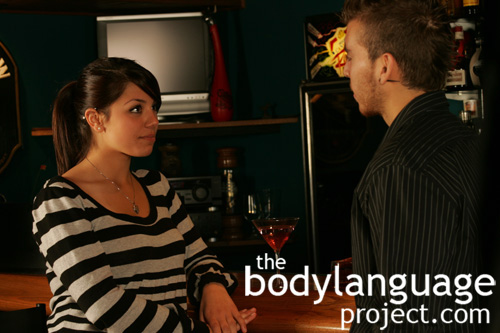Body Language of Friendly Social Gaze
Synonym(s): Friendly Eye Contact.
Description: In the friendly gaze, the eyes travel in a triangular pattern from eye-to-eye then to the mouth with some infrequent looks to the rest of the body.
In One Sentence: The friendly social gaze is a nonverbal eye pattern signally a platonic relationship.
How To Use it: To use the friendly gaze, keep the eyes moving about the face with rare glances to the rest of the body. Unlike the business gaze, it is permissible to drop the eyes to the rest of the body, but not to focus on sexual aspects such as breasts, chests, shoulders (in men), and genitals/buttocks. Use the friendly gaze when you want to be clear about a lack of sexual interest. This is especially important to married men and women, whom do not wish to send the wrong impression. In other words, those already in relationships should avoid any other type of eye gaze pattern (besides the business eye gaze pattern) or it may demonstrate unwanted insinuations and therefore may lead to unwanted results.
Context: General.
Verbal Translation: “We’re friends and I show this to you by not looking at your sexual parts, although I do infrequently inspect the rest of your body (to size you up). However, I do spend most of the time looking at your face to judge your reactions and emotions.”
Variant: See Gazing Adoringly, Gaze Omission, Eye Aversion, Gaze Avoidance and Wandering Eyes.
Cue In Action: During coffee, Dave and Jill engaged in a long conversation about computer programming never once checking each other out below the chin.
Meaning and/or Motivation: When friends talk to one another they aren’t trying to peer into their souls, rather, they gaze.
The gaze is non-threatening and like the intimate gaze, the eyes travel over the face in a specific pattern. The reason we cast our eyes infrequently over other parts of the body in the friendly gaze is simply due to the reason that it is of less interest and of less value in friendship. This is just the opposite of that which happens in the intimate gaze.
With friends, gaze is brief, lasting only about three seconds followed by looking away.
The research tells us that about seventy-five percent of the time eyes travel through the triangular pattern from the eyes to the mouth, ten percent of the time is spent on forays to the forehead and hair, and five percent to the chin, with the remaining time split on various other features.
After a period of gaze or mutual eye-contact both people will avert their eyes downward instead of left, right or upward. Looking down, on the other hand is a symbol of submission whereas looking left or right can imply disinterest (or interest in something else), or a desire to withdraw from the conversation.
Cue Cluster: N/A
Body Language Category: Attentive, Confident body language, Eye Language, Indicator of interest (IoI), Liking.
Resources:
Argyle, Michael; Lefebvre, Luc; Cook, Mark 1974. The meaning of five patterns of gaze. European Journal of Social Psychology. 4(2): 125-136.
Argyle, M., and Ingham, R. 1972. Gaze, mutual gaze, and proximity. Semiotica, 1, 32–49.
Argyle, M. and Cook, M. Gaze and Mutual Gaze. London: Cambridge University Press, 1976.
Allan Mazur; Eugene Rosa; Mark Faupel; Joshua Heller; Russell Leen; Blake Thurman. Physiological Aspects of Communication Via Mutual Gaze. The American Journal of Sociology. 1980; 86(1): 50-74.
Breed, G., Christiansen, E., & Larson, D. 1972. Effect of lecturer’s gaze direction upon
teaching effectiveness. Catalog of Selected Documents in Psychology, 2: 115.
Ellsworth, Phoebe; Carlsmith, J Merrill. 1973. Eye contact and gaze aversion in an aggressive encounter. Journal of Personality and Social Psychology. 28(2): 280-292.
Foddy, Margaret 1978. Patterns of Gaze in Cooperative and Competitive Negotiation
Human Relations. 31(11):925-938.
Kellerman. 1989. Looking and loving: The effects of mutual gaze on feelings of romantic love. Journal of Research in Personality. 23(2): 145-161.
Kendon, A. Some Functions of Gaze Direction in Social Interaction. Acta Psychologica. 1967. 32: 1-25.
Kleinke, C. L. 1980. Interaction between gaze and legitimacy of request on compliance in a field setting. Journal of Nonverbal Behavior 5(1): 3-12.
Leeb. 2004. Here’s Looking at You, Kid! A Longitudinal Study of Perceived Gender Differences in Mutual Gaze Behavior in Young Infants Source: Sex Roles. 50(1-2): 1-14.
Langer, Julia and Rodebaugh, Thomas. Social Anxiety and Gaze Avoidance: Averting Gaze but not Anxiety. Cognitive Therapy and Research, 2013, Vol.37(6): 1110-1120.
McAndrew. 1986. Arousal seeking and the maintenance of mutual gaze in same and mixed sex dyads Source: Journal of nonverbal behavior. 10(3):168-172.
Mulac, A., Studley, L., Wiemann, J., & Bradac, J. 1987. Male/female gaze in same-sex
and mixed-sex dyads. Human Communication Research. 13: 323-343.
Natale, Michael. 1976. A Markovian model of adult gaze behavior. Journal of Psycholinguistic Research. 5(1): 53-63.
Phelps, F., Doherty-Sneddon, G., & Warnock Educational Psychology., 27, 91-107. (2006). Functional benefits of children’s gaze aversion during questioning. British Journal Developmental Psychology. 24: 577-588.
Rosenfeld, H., Breck, B., Smith, S., & Kehoe, S. 1984. Intimacy-mediators of the proximity-gaze compensation effect: Movement, conversational role, acquaintance, and gender. Journal of Nonverbal Behavior. 8: 235-249.
Williams. 1993. Effects of Mutual Gaze and Touch on Attraction, Mood, and Cardiovascular Reactivity Source: Journal of Research in Personality. 27(2): 170-183.

